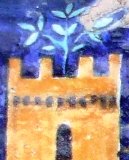| The castle of Deruta in a ceramic plaque of the 1940s (photo by Roberta Niccacci) |
If you are in the Piegaro - Città della Pieve - Fontignano area you might think of yourself as belonging to the flourishing Renaissance history of Deruta; by accompanying Maestro Pietro Vannucci known as "Perugino" (1448-1523) from Città della Pieve to Deruta in one of his trips to the town of ceramics.
This great artist of Italian art history was born in Città della Pieve and died in Fontignano, where he is buried. Perugino was one of the most important local and famous artists who inspired the ceramic art of Deruta, together with Bernardino di Betto known as "Pinturicchio" (1452-1513).
Between 1477-1478 the community of Deruta commissioned Perugino a votive offering (that we call "ex-voto" using the Latin expression) as a thank you for the end of the town's plague. This is one of the reasons why Perugino came to Deruta often, painting his fresco for the town of Deruta.
Also during the Renaissance period, Deruta was a famous place for VIPs such as the Borgia and Sforza families, artists, merchants, and bankers.
 |
| Detail of a fresco by Perugino from the "Nobile Collegio del Cambio" in Perugia (money exchange office) Deruta ceramic artists took their inspiration from this hat's floral swirls as an example. |
At that time according to available literature, there were about ten ceramic workshops, churches, a hospital for pilgrims, and a few banks with a population of about one thousand Derutese.
 |
| Reproduction of a ceramic pitcher from the origins of the history of ceramic in Deruta. |
 |
| Handpainted Reproduction of the famous work of art by Leonardo da Vinci "Lady with an Ermine" (By Romano Ranieri) |
Indeed with the passing of time, the ceramic tradition evolved to more elaborate designs which are distinguishing Deruta. Namely creating historical drawings such as the"Raffaellesco" and "Ricco Deruta" patterns; with a wide palette of colors from blue to yellow, orange, rust, green and red. Inspired by Renaissance talented artists they started reproducing scenes, profiles, and decorations into ceramic pieces, imitating the noble art of frescoes.
 |
| The original painting by Leonardo da Vinci, "Lady with an Ermine" (about A.D. 1490) |
Saint Catherine of Alexandria is the Patron Saint of Deruta ceramicists and is celebrated every year on November 25th. Her symbol is the wheel, known as Catherine's wheel: Deruta is famous for round shapes and terracotta's most production is made on the kick wheel. This is what Deruta is famous for and why this Saint is so meaningful to ceramic artists.
 |
Rue on top of the
tower. this is where
the name Deruta
comes from.
Detail of the crest
of Deruta
|
p.s. Piegaro is about 40 km away from Deruta by car, an estimate 50 minutes drive.
-----------------------------------------
FRIENDS OF CAMA

Nessun commento:
Posta un commento